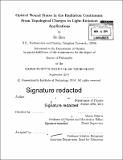| dc.contributor.advisor | Marin Soljačić. | en_US |
| dc.contributor.author | Zhen, Bo, Ph. D. Massachusetts Institute of Technology | en_US |
| dc.contributor.other | Massachusetts Institute of Technology. Department of Physics. | en_US |
| dc.date.accessioned | 2015-03-05T15:56:15Z | |
| dc.date.available | 2015-03-05T15:56:15Z | |
| dc.date.copyright | 2014 | en_US |
| dc.date.issued | 2014 | en_US |
| dc.identifier.uri | http://hdl.handle.net/1721.1/95849 | |
| dc.description | Thesis: Ph. D., Massachusetts Institute of Technology, Department of Physics, 2014. | en_US |
| dc.description | Cataloged from PDF version of thesis. | en_US |
| dc.description | Includes bibliographical references (pages 83-89). | en_US |
| dc.description.abstract | Bound states in the continuum (BICs) are unusual solutions of wave equations describing light or matter: they are discrete and spatially bounded, but exist at the same energy as a continuum of states which propagate to infinity. In this thesis, we will explore optical BICs from different perspectives, including physical intuitions, fundamental theories, sample fabrications, experimental setups, and real-life applications. First, we demonstrate the existence of such exceptions realized in macroscopic two dimensional periodic photonic crystals slab. The reason for these special modes to completely decouple from the continuum of free-space modes is through mismatching their symmetries. Further, we distinguish these special non-degenerate states with quality factors as high as 10' that extend over 108 unit cells from other existing modes in the system. Then, we show BICs have profound implications in light-emission applications. When coupling these special states to emitters, we demonstrate greatly enhanced and strongly modulated spontaneous emission from organic molecules, due to the unique properties of BICs. Furthermore, these BICs enable lasing of organic molecules with threshold at least one order of magnitude lower than previous reported results. Third, we demonstrate a different kind of BICs: those are not protected by symmetry incompatibility. We experimentally demonstrate that light can be perfectly confined in a patterned dielectric slab, even though outgoing waves (symmetry compatible) are allowed in the surrounding medium. Such states exist stably in a general class of geometries where all of its radiation amplitudes vanish simultaneously due to destructive interference. Finally, we provide a fundamental understanding about the nature of BICs that unify both types of BICs. We also explain the robustness of them through their topological nature. We show that both types of BICs are vortex centers in the polarization direction of far-field radiation. The robustness of these BICs is due to the existence of conserved and quantized topological charges, defined by the winding number of the polarization vectors. Such charges can only be generated or annihilated by making large changes in the system parameters, and then only according to strict rules, which we derive and test numerically. | en_US |
| dc.description.statementofresponsibility | by Bo Zhen. | en_US |
| dc.format.extent | 89 pages | en_US |
| dc.language.iso | eng | en_US |
| dc.publisher | Massachusetts Institute of Technology | en_US |
| dc.rights | M.I.T. theses are protected by copyright. They may be viewed from this source for any purpose, but reproduction or distribution in any format is prohibited without written permission. See provided URL for inquiries about permission. | en_US |
| dc.rights.uri | http://dspace.mit.edu/handle/1721.1/7582 | en_US |
| dc.subject | Physics. | en_US |
| dc.title | Optical bound states in the radiation continuum : from topological charges to light-emission applications | en_US |
| dc.type | Thesis | en_US |
| dc.description.degree | Ph. D. | en_US |
| dc.contributor.department | Massachusetts Institute of Technology. Department of Physics | |
| dc.identifier.oclc | 903907283 | en_US |
